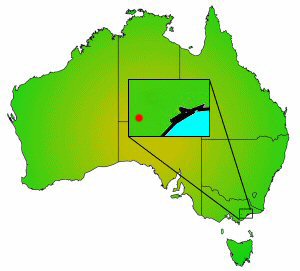Tapered galaxias facts for kids
Quick facts for kids Tapered galaxias |
|
|---|---|
| Conservation status | |
|
Critically Endangered (ASFB)
|
|
| Scientific classification | |
| Genus: |
Galaxias
|
| Species: |
lanceolatus
|
The tapered galaxias, known scientifically as Galaxias lanceolatus, is a special type of freshwater fish. It belongs to the galaxiid family and is part of the Galaxias group. This fish is also a member of the Mountain Galaxias family, which includes many similar species. You can find the tapered galaxias living in the fresh waters of Australia.
Contents
What the Tapered Galaxias Looks Like
The tapered galaxias is usually about 65 to 70 millimeters (about 2.5 to 2.7 inches) long. The longest one ever found was 84 millimeters (about 3.3 inches) long. Its body is mostly shaped like a tube, but it's a bit thin and flat on top, especially near its front fins.
Its head is a medium size and looks like a wedge from the side. The head is wider than it is deep. The lower jaw is a little shorter than the upper jaw, about 90% of its length.
The fish's back and sides are mostly brown or greyish-brown. This color also covers the top and sides of its head and snout. Its lower sides are brown to tan, and its belly is light brown or cream. You might see brown or almost black blotches on its sides, sometimes shaped like small arrows. It also has a faint line of gold speckles along its sides. The parts covering its gills are clear, with a small golden spot. Its eyes are a coppery color, and its fins are grey and clear.
Where the Tapered Galaxias Lives
The tapered galaxias has only been found in the upper parts of Stoney Creek. This creek is located in the Thomson River area, which is in west Gippsland, Australia. These fish have been caught in a small part of the stream, only about 10 kilometers (about 6 miles) long. This area is about 690 meters (about 2,260 feet) above sea level.
We don't know how far downstream this fish used to live. There are no records of it in areas where introduced trout now live. This includes other nearby streams within the Thomson River system.
In its home area, the tapered galaxias is the only type of mountain galaxias. Another similar fish, the Shaw galaxias (G.gunaikurnai), lives about 70 kilometers (about 43 miles) east of Stoney Creek. It is in a separate part of the Macalister River, which is also in the Thomson River basin.
Other native animals found in the same area include:
- Climbing galaxias (G.brevipinnis)
- Short-finned eel (Anguilla australis)
- Central highlands spiny crayfish (Euastacus woiwuru)
- Gippsland spiny crayfish (Euastacus kershawi)
- Common freshwater shrimp (Paratya australiensis)
The Tapered Galaxias's Home
The tapered galaxias lives in a small, cool, and clear creek. The creek is usually between 0.5 and 1.5 meters (about 1.6 to 4.9 feet) wide. It is also quite shallow, only about 100 to 500 millimeters (about 4 to 20 inches) deep. This creek flows slowly through a forested area.
The bottom of the stream is mostly covered with cobble stones. There are also areas with bedrock, gravel, and sand. The fish's home includes places with undercut banks (where the bank hangs over the water) and rocks. There is also woody debris and plants growing along the sides of the stream.
Life Cycle and Reproduction
The tapered galaxias is a purely freshwater fish. This is different from many other Galaxias species, which travel to the sea as part of their life cycle.
We don't know exactly when the tapered galaxias breeds. However, scientists think it might be in late winter to early spring. This is because female fish caught in May had eggs that were ready to develop. Some male fish were also ready to reproduce at that time.
Conservation Status
The tapered galaxias is in serious trouble. It is listed as critically endangered. This means it is at a very high risk of disappearing forever. The fish is protected under the Victorian Flora and Fauna Guarantee Act 1988, a law designed to help save plants and animals in Victoria, Australia.
Why This Fish is Important to Humans
Because the tapered galaxias is small and critically endangered, people do not fish for it. Its main importance is as a unique part of Australia's natural freshwater ecosystems. Protecting it helps keep the balance of nature in its habitat.


